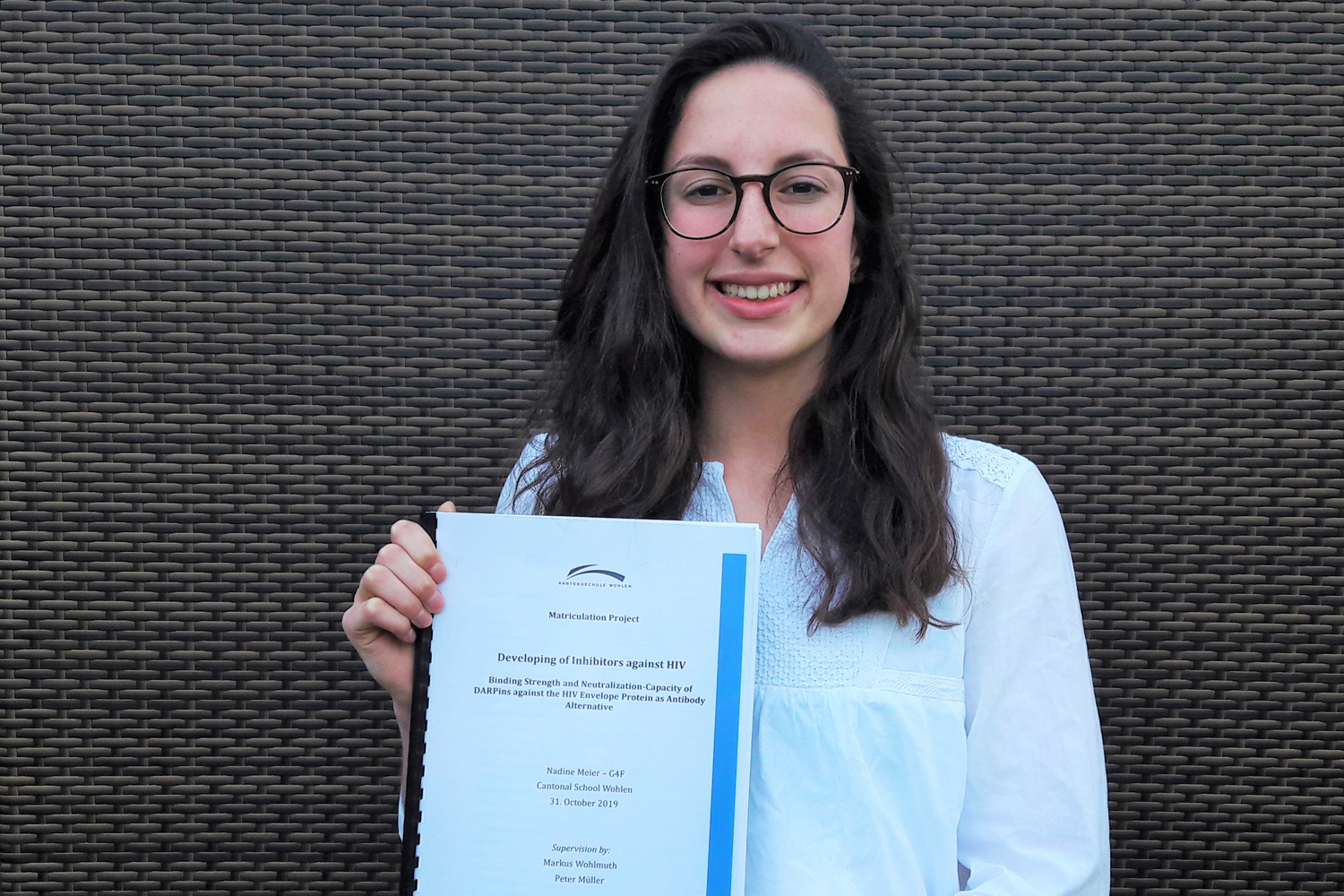Chemie | Biochemie | Medizin
Nadine Meier, 2000 | Auw, AG
The Human Immunodeficiency Virus (HIV) poses one of the greatest human threats world-wide. Many attempts to find a vaccine or a definite elimination of HIV have so far not been successful. Now a novel class of synthetic molecules known as Design Ankyrin Repeat Proteins (DARPins) have been designed which can recognize targets with affinities and specificities that can surpass those of antibodies. Previously, DARPins have been tested on their binding strength to the HIV envelope protein as well on their inhibition potency. In this study, DARPins were produced, purified and characterized according to a Neutralization Assay and ELISA. The purified DARPins showed high neutralization potency to pseudoviruses and strong binding to selected protein targets. As DARPins have been shown to be potent inhibitors, they could be used to detect virus infected cells and also have great potential in therapeutic applications and similar research areas.
Fragestellung
One major pathological hallmark of HIV is its trimeric envelope glycoprotein (Env). The vast variability of the Env is one of the main reasons why HIV can successfully evade the host immune system.
As Mosavi et al. reported, a new approach to find an alternative to broadly neutralizing Antibodies (bnAbs) led to the development of the binding protein DARPin. The aim of this study was to contribute to ongoing efforts in HIV research by clarifying whether DARPins could be applied as a synthetic antibody alternative. Previous studies have already reported that DARPins can detect targets with affinities and specificities equally or even better than antibodies. It was therefore hypothesized that well-chosen HIV-specific DARPin selections might be used as inhibitors of HIV.
Methodik
In collaboration with the HIV research group at the Institute for Medical Virology, eight DARPins from two selections were expressed in E.coli, then purified through several steps and afterwards adapted to a Neutralization Assay. The Neutralization Assay is a method performed on TZM-bl cells to detect the neutralization potency of a specific target, in this case pseudoviruses (with cloned HIV Env), with CD4 binding site directed DARPins. DARPins were serially diluted before incubating them with the pseudoviruses, after which the mixture was added to TZM-bl cells. Additionally, ELISA was applied (with cloned HIV Env targets) as a second method in order to investigate the binding-strength of the selected DARPins.
Ergebnisse
The Neutralization Assay clearly showed that six out of ten pseudoviruses could be neutralized by all DARPins. The Neutralization Assay turned out to be reliable based on the applied Murine Leukaemia Virus, which served as a negative viral control, showing no neutralization at all. Especially DARPin 106.2 H5 (a positive control) and DARPin 202.2 H5 yielded remarkable results, as they neutralized all tested pseudoviruses. In addition to that, three out of five targets from ELISA also bound DARPin 106.2 H5 and DARPin 202.2 H5. In conclusion, both hypotheses could be confirmed, as the data demonstrates that the selected DARPins are HIV-1 specific and bind to HIV Env cloned pseudoviruses and HIV Env cloned targets.
Diskussion
According to the results in this thesis, control 106.5 H5 was well chosen as it proved to be reliable in the experiments. Furthermore, the potential of DARPins to neutralize HIV Env proteins could be verified. Moreover, DARPin 202.2 H2 presents a promising candidate for additional research in order to modify its features. Although both hypotheses could be verified, the exact binding mechanism and binding site of the DARPins remains unknown.
Schlussfolgerungen
This study verified that DARPins could potentially be used as alternatives to bnAbs for therapeutic purposes. By applying envelope-binding DARPins to target infected cells that express the viral surface protein on their cellular membrane in HIV-1 infected individuals, this could be used therapeutically to reduce and eventually eliminate proviral reservoirs. In summary it can be said, therefore, that due to the various positive features of DARPins, the interest in DARPin-technology is highly justified. It thus appears that DARPins, or protein engineering in general, will play a major role in the development of future medicines.
Würdigung durch den Experten
Prof. em. Dr. Walter Schaffner
Gegen HIV gibt es nach wie vor keine Impfung. Als mögliche Alternative zu Antikörpern werden DARPins in Betracht gezogen, kleine, gentechnisch hergestellte Proteine, welche durch Mutation/Selektion auf ein gewünschtes Ziel (Epitop) gerichtet werden können. Nadine Meier hat an der Med. Virologie UZH eine Palette von DARPins auf ihre Bindung an das virale Oberflächenprotein Env und die Fähigkeit zur Neutralisierung eines HIV-Pseudovirus untersucht und gefunden, dass der DARPin Klon 202.2H2 am breitesten wirkt. Ihre sorgfältige Arbeit zeugt von grossem Einsatz auf diesem höchst aktuellen Gebiet.
Prädikat:
sehr gut
Kantonsschule Wohlen
Lehrer: Dipl. Nat ETHZ Markus Wohlmuth



